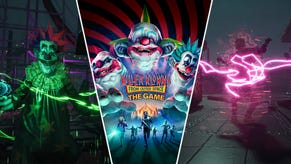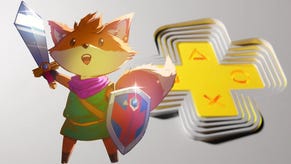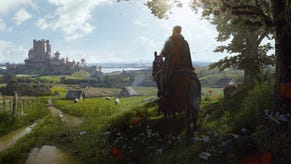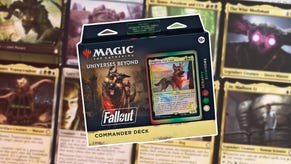20 Brilliant Things About PlayStation
The USgamer team marks the console's 20th anniversary by recounting 20 memorable PS1 experiences.
This article first appeared on USgamer, a partner publication of VG247. Some content, such as this article, has been migrated to VG247 for posterity after USgamer's closure - but it has not been edited or further vetted by the VG247 team.
It was 20 years ago today that Sony Computer Entertainment launched its very first console, the PlayStation, in the U.S. And, much like Sgt. Pepper's esteemed band, the brand has been going in and out of style ever since (poor, poor Vita).
PlayStation may well have been the first universal console — the one that every serious gamer owned, regardless of where in the world they lived. And fittingly, we at USgamer have plenty of PlayStation memories to go around. For the system's 20th anniversary, we've thumbed through our brain files to contemplate our most striking PlayStation memories.

1. 40 U.S. Dollars
I rolled into the 32-bit generation intent on totally skipping 32 bits and going directly to 64. I’d been a Nintendo owner since the early NES days and, a decade later, didn’t see the need to change. But after dropping $80-90 apiece on several Nintendo 64 duds like Turok: Dinosaur Hunter, and seeing very little of interest in the future outside of first-party titles, I realized Nintendo was no longer the happening place for games and traded for a PlayStation. A few months later, I was stunned to spot a number of new releases for PS1 selling at pricey Toys R Us for a mere $40 — half the price of most N64 games. Those early wallet-friendly releases like Parappa the Rapper and Bushido Blade helped pave the way for a low-cost gaming niche where innovation and risky design thrived… something impossible for all but first-party games on cart-based systems. PlayStation wasn’t the first CD-based console, of course, but it was the first run by a company with the foresight to leverage the low overhead of CD manufacturing as a means of delivering daring content. — Jeremy

2. CG Cutscenes
Cutscenes were not a thing that you skipped on the PlayStation. They were a reward for completing a hard battle; a mind-blowing bit of eye candy in which the PlayStation's CD storage was flaunted to the max. Square had the best cutscenes in those days, and they were used to make games like Final Fantasy VIII and Parasite Eve pop in a way they never could have on the SNES. They seem passe now; but for Sony, they ended the CD-ROM vs. cartridge debate before it ever really began. — Kat

3. Cheaper Entry for Developers
One major issue that many publishers had with prior generations of consoles was the sheer cost of manufacturing cartridges. You paid up front, and if you didn't sell your print run, you'd be in the hole for a potentially very large amount of cash. Games on CD were far cheaper to make, and that enabled companies who'd previously been unable to afford to make console games to enter the market. It also opened up the door to more risky and niche games; since the margins were less tight on manufacturing, companies could take a bigger risk with potentially unproven IPs and one-off games. — Jaz

4. Demo Discs
In the days before demos became freely available over the internet, there were demo discs—a treasure trove of sneak previews that in their own way could be as compelling as a packaged product. I could spend hours crawling through those demo discs, like going to an open buffet and trying a little bit of everything. The most famous PlayStation demo is still Final Fantasy VII, which sparked the sensation that would ultimately propel RPGs into the public consciousness. A friend of mine got the disc and had to call me at 1am just to tell me how amazing the summons looked. On the PlayStation, demos had real power. — Kat

5. The Dual Shock
The 32-bit generation made analog sticks a standard feature of any console controller, but only Nintendo (due to the N64's late arrival) had the foresight to include them from day one. The DualShock was well worth the wait, though, as it made some minor improvements to the already comfortable Dual Analog Controller, and added a rumble feature (hence the "Shock") far more sophisticated than what the N64 had to offer. We may be inured to the buzzing of controllers these days, but it was nothing short of revelatory to feel the intensity of the rumble lessen as Metal Gear Solid's Hind D flew away from the camera. Simply put, there's a reason Sony hasn't deviated too much from the DualShock's time-tested design. — Bob

6. East Meets West
It wasn’t just Japan that rocked on PlayStation; Sony’s system was the first console where Japanese and Western developers stood on equal footing, where the longstanding rule that Japan dominated consoles and America and Europe owned PCs began to break down. Tomb Raider, Soul Reaver, Wipeout, Spyro the Dragon, Fear Effect — the hits just kept coming, from both sides of both oceans. — Jeremy

7. GameShark
Yes, the Super NES and Genesis had the Game Genie, but the PlayStation Game Shark (or Action Replay) was on a whole new level. You stuck the GameShark on the back of the PlayStation and it felt like upgrading your system. If you had a Pro unit, you could even make your own codes; getting in there and messing with Hex values was awesome. And most of the gaming magazines shared the best codes! Sure, there were glitches and other issues, but GameShark was the height of cheating. It's never been the same on consoles since. — Mike

8. Gran Turismo
I first saw Gran Turismo being demoed in late 1997, and I could barely believe how realistic it looked. 3DO Need for Speed had set a fairly high bar for realistic car racing a couple of years earlier, but Gran Turismo totally blew its doors off. Featuring a huge roster of real cars that were faithfully rendered - at least, as faithfully as the PlayStation's resolution would allow - and the most realistic racetracks yet seen, Gran Turismo became a must-have game for any PlayStation owner with an interest in autos. — Jaz

9. Greatest Hits
It might be hard to remember in this age where digital sales have made most games practically free, but this little hobby of our used to be inordinately expensive. Cartridges would often sell for upwards of 80 dollars: a major investment in mid-'90s-bucks. Thankfully, not long into the PlayStation's lifespan, Sony introduced the Greatest Hits line of reprints, which gave consumers access to old games for only 20 dollars—an incredibly small asking price for an unopened game. You would, of course, have to suffer the indignity of having your discount game's package branded with a hideous green stripe, but it was a small price to pay in the grand scheme of things. — Bob
10. Hidden Soundtracks
Got a copy of Castlevania: Symphony of the Night? Pop it into a CD player and listen to one of the best hidden tracks ever. The PlayStation's audio playback capabilities were a bit overblown as a selling point, but that Symphony of the Night track is a classic. — Kat

11. The Import Treasure Trove
Here in America, we had no shortage of great games to enjoy on PlayStation; the success of Final Fantasy VII and the sheer breadth of the system’s popularity opened the doors to all kinds of creative, wacky Japanese releases like Trap Gunner, Rising Zan, and Incredible Crisis. But for those with the desire, the cash, and the willingness to constantly update their GameSharks to beat ever-evolving mod-chip lockouts, the PlayStation offered an impossible bounty of games that never made their way to America. From bold 2D action games like Gunners Heaven and Umihara Kawase Shun to more esoteric works like IntiCreates’ Speed Power Gunbike, a video game adaptation of Battle Angel Alita, Cameltry clone Koro Koro Post Nin, a number of unlocalized Shin Megami Tensei games… the PlayStation was every Japanophile’s best friend. — Jeremy

12. Memory Cards
Remember carrying these things around? These were the days before everything that was our gaming life was tied to a system ot a cloud-based account. In the PlayStation era, your memory card was your gaming world. There were a standard 15 blocks to save your game progress, so you had to pick and choose which saves you kept if you were an avid gamer. Some people even had multiple cards for separate gaming genres or family members. There were drawbacks of course - god forbid if you lost your memory card - but I remember sorting through four different memory cards as the PlayStation era came to a close. Good times. — Mike
13. Memory Cards (Redux)
In olden times, saves were always tied to the game itself, but PlayStation changed all that with the introduction of the Memory Card. And while some consumers balked at having to fork over $19.99 for what amounted to a mandatory add-on, these little chunks of rewritable media gave us freedom we never had before. With Memory Cards, we could rent games without having to worry about finishing them in a few days, take our saves elsewhere while leaving the expensive discs behind, and keep a record of our achievements long after selling the games associated with them. If you don't have an end-of-game Final Fantasy VII save on a Memory Card buried somewhere in your closet, you're just not living right. — Bob

14. Piracy
I was a PlayStation pirate. I admit it. I was young, I had just gotten to college with that fancy ethernet, and my brand-new computer had a CD-R burner. That doesn't excuse it, but I took my PS1 down to a local shop, got the modchip installed, and never looked back. It was just so damn easy to download games, burn them, and start playing. I played so many games. Even better was the ability to pick up Japanese titles region-free for the first time! Yes, piracy is wrong, but I'm not sure I would be where I am now if it wasn't so easy to pirate games on the PlayStation. — Mike

15. PlayStation Dual Analog Controller
My all-time favorite controller is the Dual Shock, so it goes without saying that the PlayStation's introduction of its standard controller, and a few years later the Dual Analog are both hugely important events for me. Before the PlayStation controller, most games machines featured joypads that seemed like minor upgrades to the flat style introduced by Nintendo a decade earlier. Sony's controller felt like it was a generation ahead - extremely well designed and ergonomic, making it comfortable and easy for most gamers to use. — Jaz

16. Polygons!
This was the generation where we moved from sprites to polygons in a major way. the first PlayStation was where developer got to experiment and play around with using polygons as crude representations of characters and vehicles. Some experiments where more successful than others. The PlayStation gave us Tekken, Battle Arena Toshiden, Twisted Metal, Ridge Racer and Resident Evil in all their polygon glory. — Mike

17. The Squaresoft Golden Age
Final Fantasy VII, VIII, and IX. Bushido Blade. Einhänder. Final Fantasy Tactics. Legend of Mana. Threads of Fate. Chrono Cross. Xenogears. Front Mission 3. Vagrant Story. Even the SaGa Frontier games, dammit. Has any publisher ever delivered so much top-flight RPG greatness in such a short span of time as Square did on PS1? Amazing. — Jeremy

18. Survival Horror
Capcom sparked a revolution with the 1996 release of Resident Evil, and while survival horror for a mainstream audience wouldn't last for much more than five years, that half-decade gave plenty of players new and often frustrating experiences games didn't really offer before. Where most game sought to empower the player, survival horror set out to do the exact opposite by throwing you into the role of entirely average people lacking the necessary resources to fight off the surrounding threats. These games might not be for everyone, but if you can handle the stress, they make for some of the most harrowing experiences you can have while holding a controller. — Bob

19. Valkyrie Profile
Japanese roleplaying development was at its most daring in the PlayStation era, and nowhere is that more evident than in Enix's Valkyrie Profile—an overlooked classic in which a Valkyrie races against time to collect souls ahead of Ragnorok (at least... that's what she's supposed to be doing). Valkyrie Profile had a lot of interesting ideas, but perhaps the most interesting was the hidden storyline that ran concurrently with the main story and could only be unlocked by effectively ignoring the game's main premise. It ultimately tanked in the U.S.; but like many other smaller RPGs, it still holds a special place in the hearts of JRPG enthusiasts. Come to me dark warriors, battle awaits us! — Kat

20. Wipeout
This to me was a watershed game. Although we'd seen the likes of SNES F-Zero, and Sega's 32x-ed Virtua Racing Deluxe during the prior generation, Wipeout was a quantum leap ahead of the racing games that had come before it. Not only was the game stunning to look at, thanks to graphic design elements from iconic 90's firm Designer's Republic, it was also brilliant to listen to. Its soundtrack includes a heap of banging choons from the likes of Chemical Brothers, Orbital, and Future Sound of London. — Jaz









